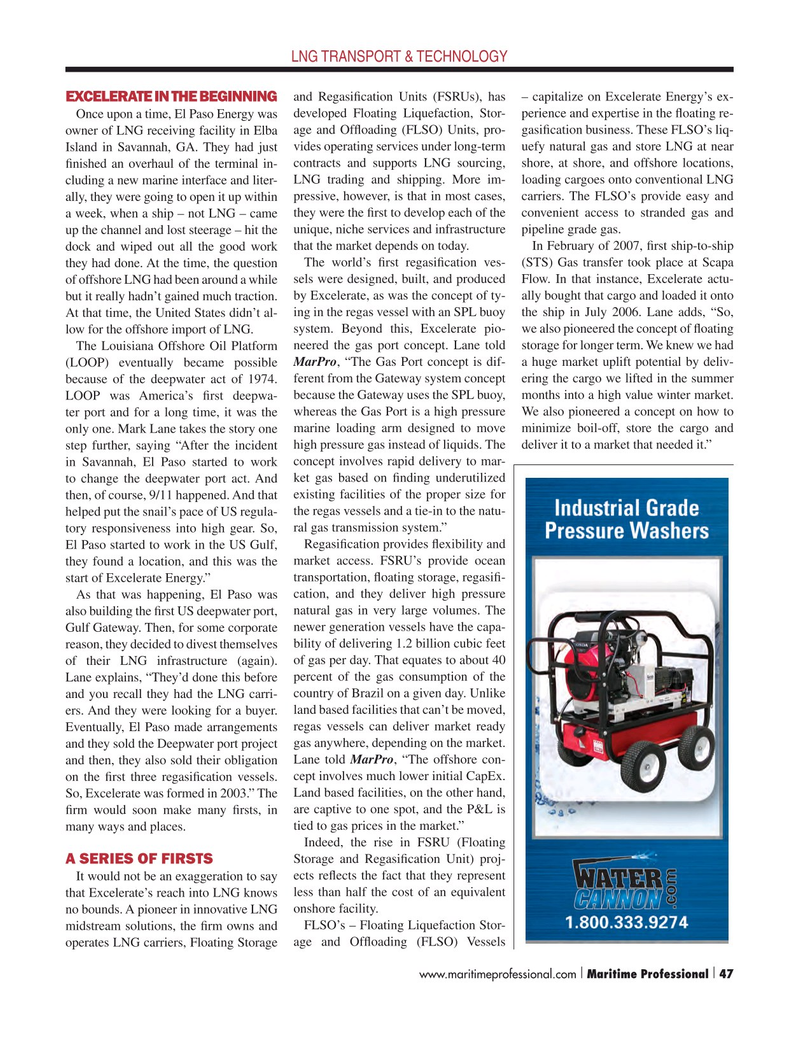
Page 47: of Maritime Logistics Professional Magazine (Q1 2015)
LNG Transport & Technology
Read this page in Pdf, Flash or Html5 edition of Q1 2015 Maritime Logistics Professional Magazine
LNG TRANSPORT & TECHNOLOGY and Regasi? cation Units (FSRUs), has – capitalize on Excelerate Energy’s ex-
EXCELERATE IN THE BEGINNING
Once upon a time, El Paso Energy was developed Floating Liquefaction, Stor- perience and expertise in the ? oating re- owner of LNG receiving facility in Elba age and Of? oading (FLSO) Units, pro- gasi? cation business. These FLSO’s liq-
Island in Savannah, GA. They had just vides operating services under long-term uefy natural gas and store LNG at near ? nished an overhaul of the terminal in- contracts and supports LNG sourcing, shore, at shore, and offshore locations, cluding a new marine interface and liter- LNG trading and shipping. More im- loading cargoes onto conventional LNG ally, they were going to open it up within pressive, however, is that in most cases, carriers. The FLSO’s provide easy and a week, when a ship – not LNG – came they were the ? rst to develop each of the convenient access to stranded gas and up the channel and lost steerage – hit the unique, niche services and infrastructure pipeline grade gas.
dock and wiped out all the good work that the market depends on today. In February of 2007, ? rst ship-to-ship they had done. At the time, the question The world’s ? rst regasi? cation ves- (STS) Gas transfer took place at Scapa of offshore LNG had been around a while sels were designed, built, and produced Flow. In that instance, Excelerate actu- but it really hadn’t gained much traction. by Excelerate, as was the concept of ty- ally bought that cargo and loaded it onto
At that time, the United States didn’t al- ing in the regas vessel with an SPL buoy the ship in July 2006. Lane adds, “So, low for the offshore import of LNG. system. Beyond this, Excelerate pio- we also pioneered the concept of ? oating
The Louisiana Offshore Oil Platform neered the gas port concept. Lane told storage for longer term. We knew we had (LOOP) eventually became possible MarPro, “The Gas Port concept is dif- a huge market uplift potential by deliv- because of the deepwater act of 1974. ferent from the Gateway system concept ering the cargo we lifted in the summer
LOOP was America’s ? rst deepwa- because the Gateway uses the SPL buoy, months into a high value winter market. ter port and for a long time, it was the whereas the Gas Port is a high pressure We also pioneered a concept on how to only one. Mark Lane takes the story one marine loading arm designed to move minimize boil-off, store the cargo and step further, saying “After the incident high pressure gas instead of liquids. The deliver it to a market that needed it.” in Savannah, El Paso started to work concept involves rapid delivery to mar- to change the deepwater port act. And ket gas based on ? nding underutilized then, of course, 9/11 happened. And that existing facilities of the proper size for helped put the snail’s pace of US regula- the regas vessels and a tie-in to the natu- tory responsiveness into high gear. So, ral gas transmission system.”
El Paso started to work in the US Gulf, Regasi? cation provides ? exibility and they found a location, and this was the market access. FSRU’s provide ocean start of Excelerate Energy.” transportation, ? oating storage, regasi? -
As that was happening, El Paso was cation, and they deliver high pressure also building the ? rst US deepwater port, natural gas in very large volumes. The
Gulf Gateway. Then, for some corporate newer generation vessels have the capa- reason, they decided to divest themselves bility of delivering 1.2 billion cubic feet of their LNG infrastructure (again). of gas per day. That equates to about 40
Lane explains, “They’d done this before percent of the gas consumption of the and you recall they had the LNG carri- country of Brazil on a given day. Unlike ers. And they were looking for a buyer. land based facilities that can’t be moved,
Eventually, El Paso made arrangements regas vessels can deliver market ready and they sold the Deepwater port project gas anywhere, depending on the market. and then, they also sold their obligation Lane told MarPro, “The offshore con- on the ? rst three regasi? cation vessels. cept involves much lower initial CapEx.
So, Excelerate was formed in 2003.” The Land based facilities, on the other hand, ? rm would soon make many ? rsts, in are captive to one spot, and the P&L is many ways and places. tied to gas prices in the market.”
Indeed, the rise in FSRU (Floating
Storage and Regasi? cation Unit) proj-
A SERIES OF FIRSTS
It would not be an exaggeration to say ects re? ects the fact that they represent that Excelerate’s reach into LNG knows less than half the cost of an equivalent no bounds. A pioneer in innovative LNG onshore facility. midstream solutions, the ? rm owns and FLSO’s – Floating Liquefaction Stor- operates LNG carriers, Floating Storage age and Of? oading (FLSO) Vessels www.maritimeprofessional.com Maritime Professional 47| |

 46
46

 48
48
